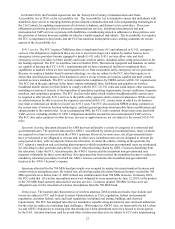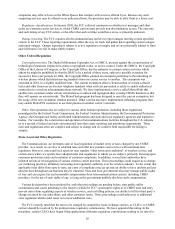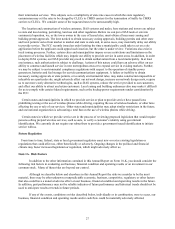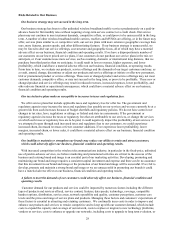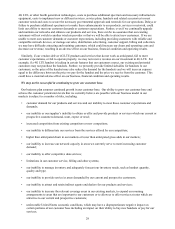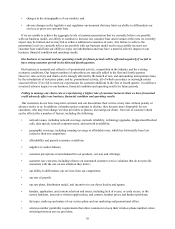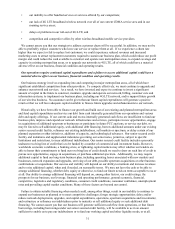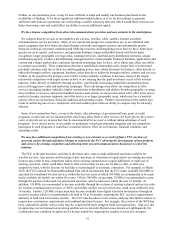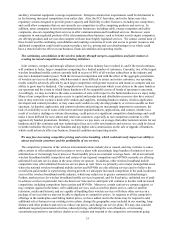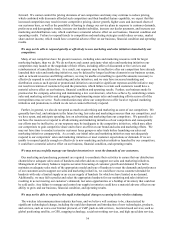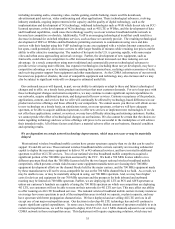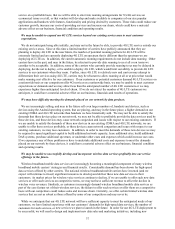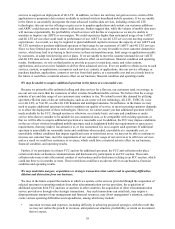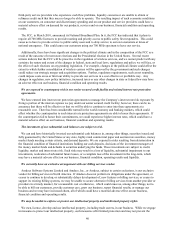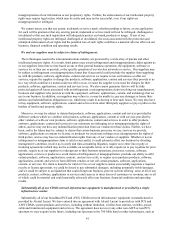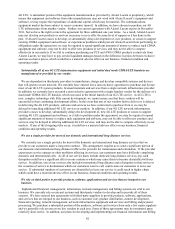Metro PCS 2010 Annual Report Download - page 42
Download and view the complete annual report
Please find page 42 of the 2010 Metro PCS annual report below. You can navigate through the pages in the report by either clicking on the pages listed below, or by using the keyword search tool below to find specific information within the annual report. 32
Further, as our operations grow, it may be more difficult to adapt and modify our business plan based on the
availability of funding. If we incur significant additional indebtedness, or if we do not continue to generate
sufficient cash from our operations, our credit ratings could be adversely affected, which would likely increase our
future borrowing costs and could affect our ability to access additional capital.
We face intense competition from other telecommunications providers and new entrants in the marketplace.
We compete directly in each of our markets with wireless, wireline, cable, satellite, Internet and other
communications service providers. Many of our current and prospective competitors are, or are affiliated with,
major companies that have better developed brands, networks and support systems, and substantially greater
financial, technical, personnel, marketing and lobbying resources and bargaining power than we have. Some have
greater access to capital, cash reserves, and spectrum holdings; longer-established brands with better name
recognition; larger geographic coverage areas, roaming territories, and third-party distribution networks; unique
intellectual property; exclusive distributorship arrangements for certain popular brands of handsets, applications and
content and a larger market share; and more advanced technology than we have, all of which may affect our ability
to compete successfully. These competitors often have established relationships with a larger base of current and
potential customers and, due to their size and bargaining power, may obtain discounts for features, either directly or
indirectly through resellers, equipment, handsets, either directly or indirectly through resellers, content, and services.
Further, as the growth in the post-pay sector of the wireless industry continues to decrease, many of the largest
nationwide competitors with ample resources have or are entering into the paid-in-advance sector of the wireless
industry, either directly or indirectly through resellers, significantly increasing competition and pushing down
prices with aggressive sales and marketing campaigns. These advantages may allow our competitors to offer
services (including, handset subsidies, higher commissions to distributors and dealers, broader geographic coverage,
more facilities or services, and greater bundled features and content) we do not and cannot offer, offer lower prices,
market to broader customer segments, and offer service over larger geographic areas, which may have a material
adverse effect on our business, financial condition and operating results. Further concentration of the market may
result in our having one or two competitors with such market power that our ability to compete may be adversely
affected.
Some of our competitors have, or may in the future, take advantage of governmental loan, grant or credit
programs, or universal service fund payments which may allow them to offer services for lower prices, have lower
costs, or provide service in areas that may be uneconomical for us to serve without taking advantage of such
programs. If we choose not to, or are unable to, participate in such governmental programs and our competitors
participate in such programs, it could have a material adverse effect on our business, financial condition, and
operating results.
We may face additional competition from existing or new entrants as a result of future FCC auctions of
spectrum and/or through legislative change or actions by the FCC allowing the development of new products
and services by existing competitors and allowing other non-telecommunications businesses to enter the
industry.
The FCC in the past has taken, and may in the future take, steps to make additional spectrum available for
wireless services. Any auction and licensing of new spectrum, or relaxation of requirements on existing spectrum
licenses may result in new competitors and/or allow existing competitors to acquire additional, or make use of
existing, spectrum, which could allow them to offer services that we may not be able to offer, or offer on a
competitive basis, with the licenses we hold due to technological or economic constraints. For example, in March
2010, the FCC released its National Broadband Plan which recommends that the FCC make available 500 MHz of
spectrum for broadband wireless services within the next ten years of which 300 MHz is recommended to be made
newly available for mobile use within five years. Of this 300 MHz of spectrum, 70 MHz is recommended to come
through the auction of allocated, but unassigned spectrum, which could occur within the next 18 months. In
addition, 110 MHz is recommended to become available through the revision of existing technical and service rules
for wireless communication services, or WCS, and mobile satellite services which also could occur within the next
18 months. Further, 120 MHz of spectrum may become available from digital television broadcasters through an
incentive auction which is recommended to be held in 24 to 36 months, assuming the FCC receives congressional
authority to hold such an incentive auction. The FCC also has taken recent actions, and may take further actions, to
impose new construction requirements on broadband spectrum licenses. For example, the revision of the WCS has
been, and mobile satellite service rules may be, coupled with more stringent build out requirements. And, as it did
in approving a recent transaction involving satellite service provider Skyterra (now known as LightSquared), the
Commission may condition its approval of a license transfer by requiring the acquirer to meet new stringent



